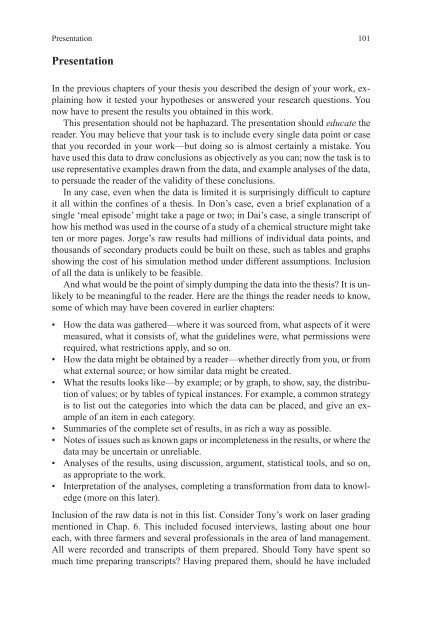How-to-Write-a-Better-Thesis
Create successful ePaper yourself
Turn your PDF publications into a flip-book with our unique Google optimized e-Paper software.
Presentation <br />
101<br />
Presentation<br />
In the previous chapters of your thesis you described the design of your work, explaining<br />
how it tested your hypotheses or answered your research questions. You<br />
now have <strong>to</strong> present the results you obtained in this work.<br />
This presentation should not be haphazard. The presentation should educate the<br />
reader. You may believe that your task is <strong>to</strong> include every single data point or case<br />
that you recorded in your work—but doing so is almost certainly a mistake. You<br />
have used this data <strong>to</strong> draw conclusions as objectively as you can; now the task is <strong>to</strong><br />
use representative examples drawn from the data, and example analyses of the data,<br />
<strong>to</strong> persuade the reader of the validity of these conclusions.<br />
In any case, even when the data is limited it is surprisingly difficult <strong>to</strong> capture<br />
it all within the confines of a thesis. In Don’s case, even a brief explanation of a<br />
single ‘meal episode’ might take a page or two; in Dai’s case, a single transcript of<br />
how his method was used in the course of a study of a chemical structure might take<br />
ten or more pages. Jorge’s raw results had millions of individual data points, and<br />
thousands of secondary products could be built on these, such as tables and graphs<br />
showing the cost of his simulation method under different assumptions. Inclusion<br />
of all the data is unlikely <strong>to</strong> be feasible.<br />
And what would be the point of simply dumping the data in<strong>to</strong> the thesis? It is unlikely<br />
<strong>to</strong> be meaningful <strong>to</strong> the reader. Here are the things the reader needs <strong>to</strong> know,<br />
some of which may have been covered in earlier chapters:<br />
• <strong>How</strong> the data was gathered—where it was sourced from, what aspects of it were<br />
measured, what it consists of, what the guidelines were, what permissions were<br />
required, what restrictions apply, and so on.<br />
• <strong>How</strong> the data might be obtained by a reader—whether directly from you, or from<br />
what external source; or how similar data might be created.<br />
• What the results looks like—by example; or by graph, <strong>to</strong> show, say, the distribution<br />
of values; or by tables of typical instances. For example, a common strategy<br />
is <strong>to</strong> list out the categories in<strong>to</strong> which the data can be placed, and give an example<br />
of an item in each category.<br />
• Summaries of the complete set of results, in as rich a way as possible.<br />
• Notes of issues such as known gaps or incompleteness in the results, or where the<br />
data may be uncertain or unreliable.<br />
• Analyses of the results, using discussion, argument, statistical <strong>to</strong>ols, and so on,<br />
as appropriate <strong>to</strong> the work.<br />
• Interpretation of the analyses, completing a transformation from data <strong>to</strong> knowledge<br />
(more on this later).<br />
Inclusion of the raw data is not in this list. Consider Tony’s work on laser grading<br />
mentioned in Chap. 6. This included focused interviews, lasting about one hour<br />
each, with three farmers and several professionals in the area of land management.<br />
All were recorded and transcripts of them prepared. Should Tony have spent so<br />
much time preparing transcripts? Having prepared them, should he have included














![[Lonely Planet] Sri Lanka](https://img.yumpu.com/59845622/1/169x260/lonely-planet-sri-lanka.jpg?quality=85)


